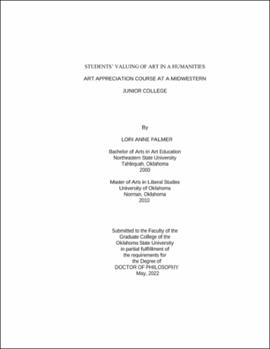| dc.description.abstract | Art Appreciation is often a course that undergraduate students take to meet their general education requirements. However, many students have little interest or value of art due to a lack of previous art experiences and often choose the course because they feel it will be relatively easy. This qualitative, naturalistic inquiry focused on students' meaning making and valuing of art as well as their perceived changes in how they value art, art's practical use, and art's benefits to individuals and society from their experiences in taking an Art Appreciation course. Altering the traditional art history, aesthetics, and art criticism approach to teaching Art Appreciation, the researcher added art production as part of the curriculum in order to facilitate a broader range of art experiences, increased artistic understanding, and valuing of art. Art is valued for intrinsic and extrinsic reasons. The review of literature concerned artistic and aesthetic valuing; art experiences in relation to one's learning, living, and psychological influences; as well as examining curriculum and teaching methods in undergraduate Art Appreciation courses. Naturalistic inquirers lean toward humans' value making and ground the theory from the data collected in a natural setting (Lincoln and Guba, 1985). Data were gathered from course assignments that included students' responses from class discussions, art history questions, art criticism activities as well as art productions. From these data, an art appreciation education theory emerged based on students' experiences that included six components: 1) a comfortable and safe learning environment; 2) foundational knowledge and application of the formal qualities of art; 3) foundational knowledge of art history and art criticism; 4) collaborative class participation opportunities through group discussions and projects; 5) hands-on, low-stakes art creation experiences; and 6) valuing reflections. The findings revealed that students expressed viewing artworks, determining how art was valued in the past and today, learning art techniques, creating art, engaging with the class, working collaboratively on art projects, and learning and critiquing artwork from history provided many benefits that could transfer to others and society and contributed to students developing their own unique standard in which to make meaning and value art. | |
